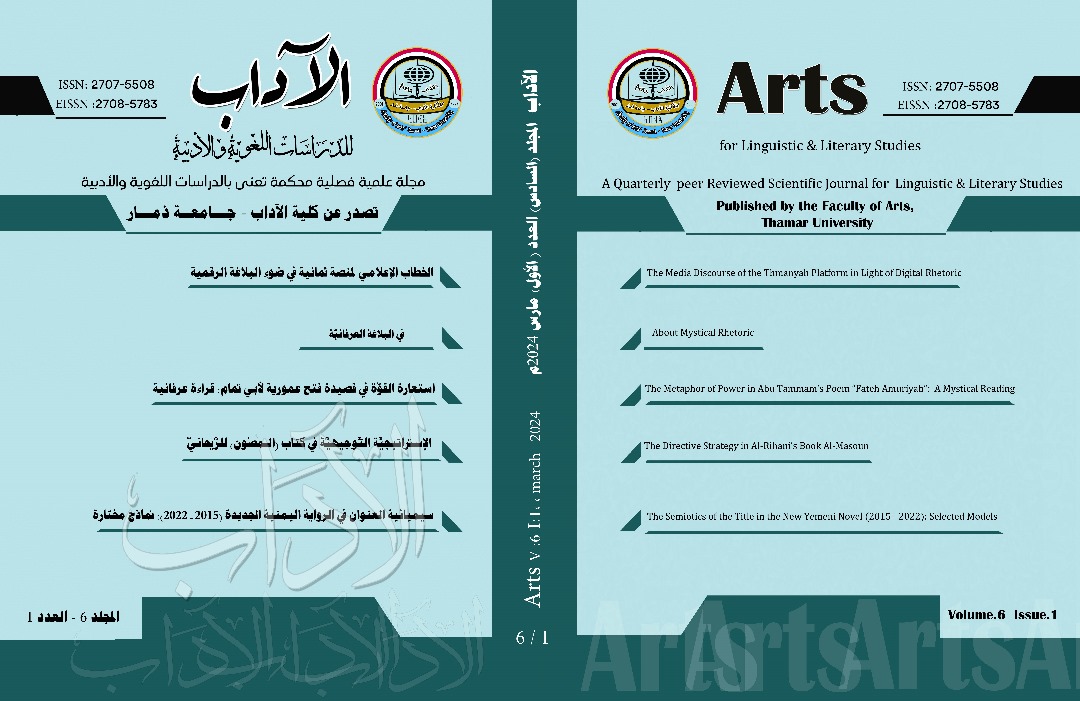Ellipsis in the Translation of Meaning of the Holy Quran: A Linguistic Analysis
DOI:
https://doi.org/10.53286/arts.v6i1.1799Keywords:
Arabic Rhetoric, Ellipsis, English translation, Linguistics, Quran, SemanticsAbstract
This study focuses on the rhetorical analysis of translation of meaning in the Quranic text which is a rich area of investigation particularly of Quranic translation of meaning in English language. The specific level of analysis is ellipsis which is the emphasis of the current study. A handful verses of the Quranic text have been selected and analyzed based on their elliptical use. The data analysis process goes through three main areas of analysis: semantic, syntactic and context levels of analysis which shapes the whole process of investigation. Finally, the findings suggest how those three aspects of analysis collaborate in creating meaning with a special reference to ellipsis. Also, the findings provide answers to the three research questions of the current study.
Downloads
References
References
Al Shurafa, N. S. D. (1995). The role of syntax and semantics in the translation of the Quran Six English versons of the last verse of Surat Al-Baqara. Turjuman Magazine, 4(2), 43-55. https://search.mandumah.com/Record/592266
Alduhaim, A. (2021). Translating near-synonyms in the Quran: A semantic analysis of three near-synonyms and their English translations. 3L: Southeast Asian Journal of English Language Studies, 27(1), 76 – 89.
Al-Hroot, A. K. (1987). Some aspects of deletion in Arabic. Indiana University.
Ali, S. S. (1992). Misrepresentation of some ellipted structures in the translation of the Qur’ān (Analytical Study). Meta (Montréal), 37(3), 487-490. 10.7202/001871ar
Al-Khawalda, M. (2011). Ellipsis in the Arabic language. Journal of Language Teaching and Research, 2(5), 1172-1177.
Allaithy, A. (2020). Challenges in translating the Qur’ān – translating the untranslatable: omission/ellipsis. In: Brunn, S., Kehrein, R. (eds) Handbook of the Changing world language map. Springer, Cham. https://doi.org/10.1007/978-3-030-02438-3_211
Al-Liheibi, F. M. M. (1999). Aspects of sentence analysis in the Arabic linguistic tradition, with particular reference to ellipsis http://ethos.bl.uk/OrderDetails.do?uin=uk.bl.ethos.313489
Al-Salami, A. A. A. R. (2022). Ellipsis as a linguistic discourse technique in Qur’anic Narratives. Eurasian Journal of Applied Linguistics, 8(1), 203-216.
Daraz, F. U. (2015). Linguistic Ellipsis and its Impact on Interpretation: An Applied Study on Quranic Verses. Journal of the Faculty of Education, Menoufia University, 28(1), 25-62.
Diraz,, M. (2019). The Great News: New Insights into the Holy Quran. Dar Ibn Rajab for printing, publishing and distribution / Dar Al-Fawaed.
El Rays, E. (2017). Ellipsis as a translation barrier in selected translations of the Holy Quran. Journal of the Faculty of Arts - Helwan University, 46(1), 80-119.
El Rays, E. (2017). Ellipsis as a translation barrier in selected translations of the Holy Quran. Journal of the Faculty of Arts - Helwan University, 46(1), 80-119.
Gunawan, F., & Boulahnane, S. (2023). Translating the Qur'an in Indonesia: Marrying the Concept of Transcreation and Critical Discourse Analysis. Indonesian Journal of English Language Teaching and Applied Linguistics, 8(2), 117-131.
Halliday, M. & Hassan, R. (1976). Cohesion in English. London: Longman
Halliday, M. A. K. (2006). Linguistic studies of text and discourse (Vol. 2). A & C Black.
Latif, Y. A. S. (2010). Jamaliyat al-Talaqi fi al-Sard al-Qurtani (Aesthetics of Receiving in Quranic Narrative) (1st ed.). Damascus: Dar Al-Zaman li- al-Tiba'ah wa al-Nashr wa al-Twawzi
Leech, G. N., & Short, M. (2007). Style in fiction: A linguistic introduction to English fictional prose (No. 13). Pearson Education.
Mark, D. (2022). Semantic decomposition of four Quranic words. Russian Journal of Linguistics, 26(4), 937-969.
Mohammed, E. (2022). The differences in translations of the meaning of the Holy Quran: a case study of three different translations of Sarah Alnur and Alhujrat. International Journal of Linguistics, Literature and Translation, 5(2), 01-08. http://doi.org/10.32996/ijllt.
Downloads
Published
How to Cite
Issue
Section
License

This work is licensed under a Creative Commons Attribution 4.0 International License.
Copyright and Licensing
copyright is retained by the authors. Articles are licensed under an open access Creative Commons CC BY 4.0 license, meaning that anyone may download and read the paper for free. In addition, the article may be reused and quoted provided that the original published version is cited. These conditions allow for maximum use and exposure of the work.



